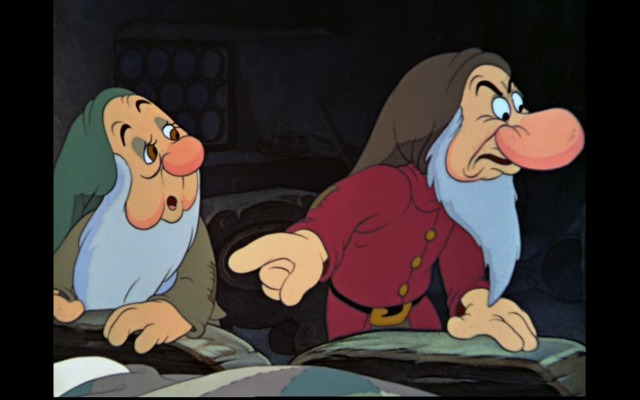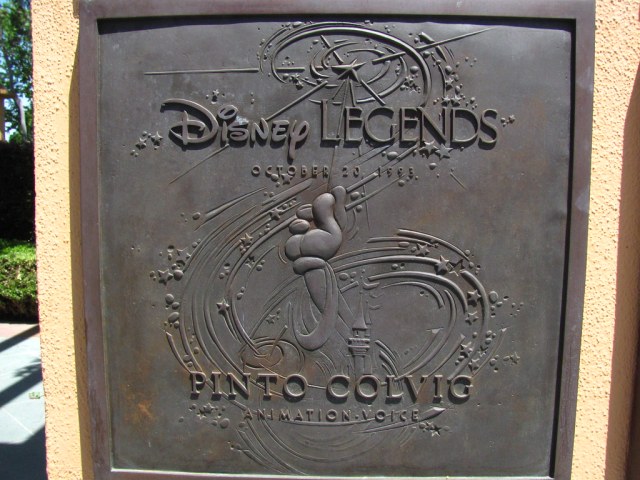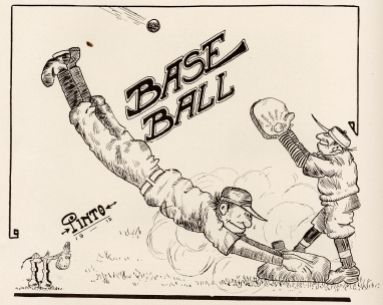
She’s a female! And all females is poison! They’re full of wicked wiles!”
–Pinto Colvig as Grumpy in Snow White and the Seven Dwarfs (1937)
Vance DeBar Colvig Sr. was born on September 11, 1892, in Jacksonville, Oregon, to Judge William Mason Colvig and Adelaide Birdseye Colvig. While attending school, young Vance was nicknamed after a spotted horse named “Pinto,” largely due to his freckled face.
Colvig enjoyed clowning from an early age. His childhood homes on Oregon Street in Jacksonville, Oregon, 295 14th Street in Portland, Oregon, and at 8 Laurel Street in Medford City, Oregon, were filled with music and laughter. He was the youngest of seven children and would strive for attention by eliciting laughter, making faces, and playing pranks. He was also a gifted mimic and would work to reproduce the sounds around him, whether they be the squeaks and clanks of everyday objects or the noises of people and animals. Colvig and his brother Don would put on minstrel shows for local functions, during which Colvig developed an interest in clarinet and later joined the town band.
Thanks to the clarinet, Colvig entered show business at age 12. While attending Portland’s Lewis and Clark Centennial Exposition with his father, Colvig told one of the performers that he played clarinet. He ran back to the hotel to get the instrument and was hired on the spot to join a fun house act. He donned oversized, worn out clothes and a derby hat, accompanied with white makeup and a clown face. The man who hired him said, “Now, you look like a real bozo,” referring to the tramp or hobo style of clowning that was in vogue during the period. His act consisted of him playing clarinet while contorting his face and crossing his eyes as the notes got higher. With this, Colvig developed a deep appreciation for circuses and carnivals.
During the winters, he continued to attend school, followed by work in the circus and in vaudeville during the spring. He studied art at Oregon Agricultural College and played with the college band. At the same time, he gained a reputation for his cartoons and his “chalk talk” routine. During his performance, he would improvise a monologue while sketching humorous cartoons in the process. His college career came to an end when he accepted an offer to perform his chalk talks for the revered Pantages vaudeville circuit in 1913. His travels in the circuit ended in Seattle, Washington, after which he joined a circus band. He would travel all over the country but would struggle financially.
By 1914, he secured a position as a newspaper cartoonist for the Nevada Rockroller in Reno, followed by Carson City News. Though his cartoonist work was earning him a paycheck, he continued to be drawn to the circus. Once Al G. Barnes’ Circus came to Carson City, Colvig joined the troupe and found himself clowning and playing the clarinet for a circus band yet again.
Due to the fact that circuses would close each winter, Colvig returned to cartooning wherever he could secure a role. During his time working for a Portland newspaper, he met and married Margaret Bourke Slavin, ending his time on the road. The couple moved to San Francisco, where four out of their five boys were born. He returned to newspaper work as a full-time cartoonist and writer for The Bulletin. His cartoon series, “Life on the Radio Wave” depicted how radio was affecting people’s lives. Colvig viewed cartoons as another means through which he could continue clowning.
As Colvig worked for the newspaper by day, he began experimenting with animation by night and set up his own studio, Pinto Cartoon Comedies Co. In doing so, he also created one of the first animated silent color films, called Pinto’s Prizma Comedy Revue (1919). Looking to advance in the business, he and his family moved to Los Angeles, where his fifth son was born.

In Los Angeles, Colvig continued working in animation and secured a job offer from Mack Sennett and the Keystone Film Co. Sennett sought an animator, which he found in Colvig. However, Colvig would also write and act in the studio’s comedies and dramas. Colvig teamed up with his friend, Walter Lantz, to create a talking cartoon. Sadly, their Bolivar, the Talking Ostrich (1928) was not a success in comparison to Walt Disney’s Steamboat Willie (1928).
Colvig and Lantz split to work with larger studios. Lantz would go on to voice Woody Woodpecker. When Lantz became producer of Universal Studios’ Oswald the Lucky Rabbit cartoons in 1929, Colvig was hired as an animator, also working as a storyman and voice artist, briefly voicing Oswald.
In 1930, Disney signed Colvig to a contract, which called for him to work on stories and co-write songs and lyrics. He also provided sound effects and the barks of Pluto the Pup. In the next year, he began voicing Goofy, who was initially named Dippy Dawg. Other notable characters he worked on included Practical Pig in the Disney short “Three Little Pigs.” He also provided Ichabod Crane’s screams in The Adventures of Ichabod and Mr. Toad (1949).
Colvig would voice both Sleepy (originally to be voiced by Sterling Holloway) and Grumpy in Snow White and the Seven Dwarfs (1937). Disney cartoonists copied many of Pinto’s facial expressions while drawing animal characters for the cartoons.

Colvig’s Sleepy is perpetually tired and weary throughout most situations during the film. Though he is laconic in the film, his exhausted character does partake in some comedy as the film progresses. Here, Sleepy is part of a running gag that has him being bothered by a fly. Initially, the gag was to culminate in Sleepy trapping the fly in Snow White’s now-empty coffin; however, this conclusion to the gag was not used.
One of the stronger characterizations of the dwarfs in the film is Grumpy, who goes through clear moments of growth and change in his personality and actions. Grumpy initially dislikes Snow While and refuses to accept her presence in the home. Over time, it is revealed that he develops a soft spot for her and fiercely defends her when she is in danger, to the point of leading the charge himself.

Colvig left Disney in 1937 following a fallout but the studio proceeded to reuse his old voice tracks. In the meantime, Colvig freelanced voices and sound effects for Warner Bros. cartoons, sang for some of the Munchkins during Dorothy’s arrival scenes in MGM’s The Wizard of Oz (1939), and also joined Max Fleischer Studios in Miami, where he did the voice of Gabby in Gulliver’s Travels (1939) and Bluto in the “Popeye the Sailor” cartoons.
Colvig returned to Disney in 1941 and freelanced for them and on various radio programs. He was the original Maxwell automobile on Jack Benny‘s show, a hiccuping horse for Dennis Day, and several voices for Amos ‘n Andy. His live radio experience and contacts introduced him to the recording industry. He did several albums before encountering one of his best-known characters, Bozo the Clown.
In between time, World War II arose and was a source of worry for Colvig’s family and many others. He and his sons were eligible for the draft and his wife’s anxiety over the possibility of her family being broken apart by war. It is likely that an illness she had was exacerbated by her worry and made her a semi-invalid for many years. Colvig cared for her until her passing in 1950. Two years later, he would remarry to Peggy Bernice Allaire.

Colvig carried out the role of Bozo for a full decade, which also included portraying the character on television. In addition to being the first actor to portray Bozo, he wrote and produced a popular series of storytelling record-album and illustrative read-along book sets, beginning with the October 1946 release of Bozo at the Circus. His record-reader concept enabled children to read and follow a story in pictures while listening to it and happened to be the first of its kind. On some of the records, Pinto provided as many as eight other voices. The record series would be a major seller for Capitol. Colvig would go on to make guest appearances in character on radio as well as in children’s hospitals and orphanages. Although Pinto’s Bozo days were over in 1956, his son, Pinto Colvig, Jr., would be chosen by KTLA-Channel 5 in Los Angeles to be the live Bozo host.
Colvig’s last known performance was as Goofy for the Telephone Pavilion at Expo 67. Colvig’s dialogue for this exhibit was recorded six months before his death. In 1963, Colvig received a letter from Oregon Senator Maurine Neuberger thanking him for supporting her bill requiring warning labels on cigarette packages. A lifelong smoker, Colvig was one of the pioneers in advocating for the inclusion of warning labels about cancer risk on cigarette packages.
On October 3, 1967, Colvig died of lung cancer at the age of 75 in Woodland Hills, California. He was interred at Holy Cross Cemetery.
Long after his passing, Colvig’s legacy remained. In 1993, he was posthumously made a Disney Legend for his contributions to Disney films, including Snow White and the Seven Dwarfs and Fun and Fancy Free (1947). His Disney Legend plaque may be viewed in the Legends Plaza at the Walt Disney Studios in Burbank, California.

Furthermore, on May 28, 2004, Colvig was inducted into the International Clown Hall of Fame in Baraboo, Wisconsin, for his work as Bozo. The International Clown Hall of Fame and Research Center is located at 102 4th Ave. in Baraboo.
In addition to these tributes, some of Colvig’s residences also remain.
In 1917, he lived at 235 Oak Street in San Francisco, California. He was already working as a cartoonist at this time. Here is the home today:

By 1920, he and his family relocated to 1385 Clay Street in San Francisco, California. This is what the property looks like at present:

Finally, once his family made the move to Los Angeles, they were listed as living at 2177 Moreno Drive in Los Angeles, California. This is the property at present:

Colvig’s talents are still enjoyed by audiences to this day, whether they are through his contributions to Disney’s characters or to those in other features.















